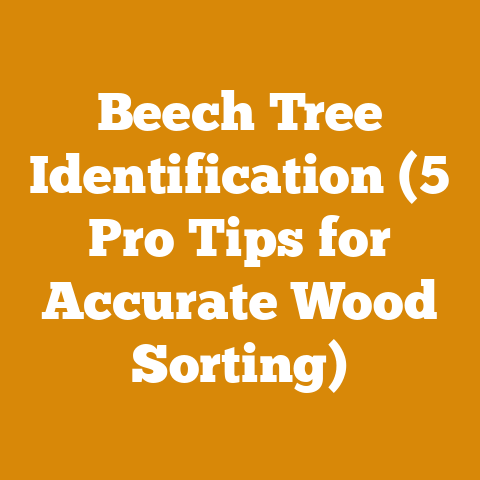Getting Rid Carpenter Bees: Simple Woodcare Hacks (Expert Tips)
Let’s dive into the world of carpenter bees and how to protect your precious wood from their destructive tendencies. I understand the frustration of seeing those perfectly round holes appear on your porch, deck, or even the siding of your home. It feels like a personal attack, doesn’t it? But don’t worry, I’m here to share my knowledge and experience to help you reclaim your wood and keep those carpenter bees at bay.
Getting Rid of Carpenter Bees: Simple Woodcare Hacks (Expert Tips)
Understanding the Enemy: Carpenter Bee Behavior
Before we jump into solutions, let’s understand our adversary. Carpenter bees, unlike honeybees or bumblebees, are solitary creatures. They don’t live in hives or produce honey. Instead, the female carpenter bee bores into wood to create a nest, a tunnel where she lays her eggs. These tunnels, typically about half an inch in diameter, can extend several inches into the wood.
-
What attracts them? Carpenter bees are drawn to softwoods like cedar, pine, redwood, and fir. They prefer bare, unpainted, or unstained wood. The texture of these woods makes them easier to drill into.
-
Damage Assessment: While a few carpenter bee holes might seem insignificant, repeated infestations over time can weaken the structural integrity of the wood. This is especially concerning for decks, porches, and support beams.
-
Life Cycle: Carpenter bees are most active in the spring and early summer when they’re mating and building nests. The larvae develop throughout the summer, and new adult bees emerge in the late summer or early fall.
Identifying Carpenter Bee Damage
Knowing the signs of carpenter bee activity is crucial for early intervention. The most obvious sign is, of course, the perfectly round holes in your wood. But there are other clues to look out for:
-
Frass: This is the sawdust-like material that carpenter bees excavate as they drill. You’ll often find it accumulating below the entrance holes.
-
Buzzing: Carpenter bees are noisy insects. You might hear them buzzing around your wooden structures, especially during the spring mating season.
-
Staining: Over time, the carpenter bee’s excrement can stain the wood around the entrance holes.
Room-Specific Needs and Wood Protection Strategies
The approach to protecting your wood from carpenter bees needs to be tailored to the specific area of your home. After all, the wood on your porch faces different challenges than the wood trim around your windows.
Porches and Decks
Porches and decks are prime targets for carpenter bees due to their exposed location and often large expanses of softwood.
-
Wood Selection: If you’re building a new porch or deck, consider using naturally insect-resistant wood species like teak, mahogany, or ironwood. While these are more expensive, they offer long-term protection. According to the Forest Products Laboratory, teak is naturally resistant to termites and carpenter bees due to its high oil content. A study published in the Journal of Economic Entomology found that teak wood suffered significantly less damage from carpenter bees compared to pine and cedar.
-
Protective Coatings: For existing porches and decks, a high-quality oil-based paint or stain is your best defense. These coatings create a barrier that makes it difficult for carpenter bees to drill into the wood. I’ve found that applying two coats, ensuring complete coverage, is essential.
-
Regular Inspection: Make it a habit to inspect your porch and deck regularly, especially in the spring. Look for new holes, frass, or bee activity. Early detection allows for prompt treatment.
-
Pressure-Treated Wood: While pressure-treated wood is resistant to rot and decay, it’s not entirely immune to carpenter bees. However, the chemicals used in the treatment process can deter them to some extent.
-
Screening: Consider installing screens around your porch or deck to create a physical barrier against carpenter bees.
Siding and Trim
Siding and trim are also vulnerable to carpenter bee damage, particularly if they’re made of softwood.
-
Wood Hardness: Use hardwoods for siding and trim wherever possible. Hardwoods like oak, maple, and birch are much more difficult for carpenter bees to drill into.
-
Painting and Caulking: Paint siding and trim regularly with high-quality exterior paint. Caulking any cracks or crevices will further deter carpenter bees from nesting.
-
Vibration Deterrents: Carpenter bees are sensitive to vibration. Mounting wind chimes or other vibrating devices near your siding can help to keep them away.
-
Natural Repellents: Plant natural repellents like lavender, citronella, and eucalyptus near your siding. The strong scents of these plants can deter carpenter bees.
Outdoor Furniture
Outdoor furniture, especially wooden benches and chairs, can also attract carpenter bees.
-
Material Selection: Choose outdoor furniture made from naturally insect-resistant wood species or alternative materials like metal or plastic.
-
Protective Finishes: Apply a protective finish to your wooden outdoor furniture, such as a sealant or varnish. This will help to prevent carpenter bees from drilling into the wood.
-
Storage: When not in use, store your outdoor furniture in a shed or garage to protect it from the elements and carpenter bees.
DIY Woodcare Hacks for Carpenter Bee Control
Now, let’s get into some practical DIY hacks that you can use to combat carpenter bees.
1. Plugging the Holes
This is a classic method for dealing with existing carpenter bee holes.
-
Materials: Wood putty, caulk, steel wool, or wooden dowels.
-
Procedure:
- Fill the holes with your chosen material. For larger holes, use wood putty or wooden dowels. For smaller holes, caulk or steel wool can be effective.
- If using wood putty or dowels, sand the surface smooth after the material has dried.
- Paint or stain the patched area to match the surrounding wood.
-
Timing is Key: The best time to plug the holes is in the late summer or fall after the carpenter bees have left their nests. This prevents you from trapping the bees inside.
2. Insecticidal Dust
Insecticidal dust is a powerful weapon against carpenter bees.
-
Product: Use a dust containing deltamethrin, cyfluthrin, or boric acid. These insecticides are effective at killing carpenter bees.
-
Application:
- Apply the dust directly into the carpenter bee holes using a duster or puffer bottle.
- Be sure to wear gloves and a mask to protect yourself from the insecticide.
- Repeat the application every few weeks, especially during the spring and summer.
-
Safety Precautions: Always follow the manufacturer’s instructions when using insecticidal dust. Keep it out of reach of children and pets.
3. Homemade Sprays
If you prefer a more natural approach, you can try making your own carpenter bee spray.
-
Recipe 1: Vinegar and Water: Mix equal parts white vinegar and water in a spray bottle. Spray directly onto carpenter bees and into their holes.
-
Recipe 2: Citrus Oil: Mix a few drops of citrus oil (like orange or lemon) with water in a spray bottle. Spray around areas where carpenter bees are active.
-
Recipe 3: Garlic Spray: Crush a few cloves of garlic and mix them with water. Let the mixture sit for a few days, then strain it and pour it into a spray bottle. Spray around areas where carpenter bees are active.
-
Effectiveness: While these homemade sprays may not be as potent as chemical insecticides, they can help to deter carpenter bees and reduce their activity.
4. Sound Deterrents
Carpenter bees are sensitive to sound and vibration. You can use this to your advantage by installing sound deterrents near your wooden structures.
-
Wind Chimes: Hang wind chimes near your porch, deck, or siding. The constant noise and vibration can help to keep carpenter bees away.
-
Ultrasonic Devices: Install ultrasonic devices that emit high-frequency sounds that are unpleasant to carpenter bees. These devices are available at most hardware stores.
-
Loud Music: Playing loud music can also deter carpenter bees, but be mindful of your neighbors!
5. Traps
Carpenter bee traps are a simple and effective way to capture and kill carpenter bees.
-
Types: There are several different types of carpenter bee traps available, including bottle traps, wooden traps, and plastic traps.
-
Placement: Hang the traps near areas where carpenter bees are active.
-
Bait: Some traps use a bait to attract carpenter bees. You can also add a few drops of citrus oil to the trap to make it more appealing.
-
Maintenance: Empty the traps regularly and dispose of the dead carpenter bees.
6. Wood Preservatives
Applying wood preservatives can help to protect your wood from carpenter bees and other wood-boring insects.
-
Types: There are several different types of wood preservatives available, including oil-based preservatives, water-based preservatives, and borate preservatives.
-
Application: Follow the manufacturer’s instructions when applying wood preservatives. Be sure to wear gloves and a mask to protect yourself from the chemicals.
-
Effectiveness: Wood preservatives can help to prevent carpenter bees from drilling into the wood and can also kill any existing carpenter bees.
Understanding the properties of different wood species can help you make informed decisions about your building materials.-
Naturally Resistant Woods:
- Teak: As mentioned earlier, teak is naturally resistant to termites and carpenter bees due to its high oil content.
- Mahogany: Mahogany is another naturally insect-resistant wood that is often used for outdoor furniture and decking.
- Ironwood: Ironwood is a very dense and durable wood that is highly resistant to insects and decay.
- Cedar: While cedar is a softwood, it contains natural oils that make it somewhat resistant to insects. However, carpenter bees may still attack cedar, especially if it’s untreated.
-
Less Resistant Woods:
- Pine: Pine is a softwood that is highly susceptible to carpenter bee damage.
- Redwood: Redwood is another softwood that is often attacked by carpenter bees.
- Fir: Fir is a softwood that is commonly used for framing and siding. It is also susceptible to carpenter bee damage.
Data-Backed Insights: Wood Durability and Cost-Effectiveness
Choosing the right wood species can have a significant impact on the durability and cost-effectiveness of your wood projects.
-
Durability: A study by the University of Florida found that teak wood can last for over 50 years with minimal maintenance, while pine wood may only last for 10-15 years.
-
Cost-Effectiveness: While naturally resistant woods like teak and mahogany are more expensive upfront, they can save you money in the long run by reducing the need for repairs and replacements.
-
Processing Efficiency: Hardwoods like oak and maple can be more difficult to work with than softwoods like pine and cedar. However, the added durability and resistance to insects make them worth the extra effort.
Case Studies: Real-World Carpenter Bee Control Projects
To illustrate the effectiveness of these woodcare hacks, let’s take a look at some real-world case studies.
Case Study 1: Porch Restoration
-
Problem: A homeowner in North Carolina had a severe carpenter bee infestation on their wooden porch. The porch was made of pine wood and had several large carpenter bee holes.
-
Solution:
- The homeowner plugged the carpenter bee holes with wood putty and sanded the surface smooth.
- They applied two coats of oil-based paint to the porch.
- They installed carpenter bee traps near the porch.
- They planted lavender and citronella around the porch.
-
Results: The carpenter bee infestation was significantly reduced, and the porch was protected from further damage.
Case Study 2: Deck Protection
-
Problem: A homeowner in California had a redwood deck that was being attacked by carpenter bees.
-
Solution:
- The homeowner applied a borate wood preservative to the deck.
- They installed ultrasonic devices near the deck.
- They regularly sprayed the deck with a homemade citrus oil spray.
-
Results: The carpenter bee activity on the deck was significantly reduced, and the deck was protected from further damage.
Safety Standards and Considerations
When dealing with carpenter bees and woodcare products, it’s essential to prioritize safety.
-
Protective Gear: Always wear gloves, a mask, and eye protection when working with insecticides, wood preservatives, or other chemicals.
-
Ventilation: Work in a well-ventilated area to avoid inhaling harmful fumes.
-
Storage: Store chemicals and woodcare products in a safe place out of reach of children and pets.
-
Disposal: Dispose of empty containers and unused chemicals properly according to local regulations.
Global Challenges Faced by Hobbyists and Professionals
Carpenter bee infestations are a global problem, and hobbyists and professionals around the world face similar challenges.
-
Climate Change: Climate change is altering the distribution and behavior of carpenter bees, making them more common in some areas and less common in others.
-
Deforestation: Deforestation is reducing the availability of natural nesting sites for carpenter bees, forcing them to seek out alternative nesting sites in wooden structures.
-
Pesticide Resistance: Some carpenter bee populations are developing resistance to common insecticides, making them more difficult to control.
Conclusion: Reclaim Your Wood!
Carpenter bees can be a nuisance, but with the right knowledge and tools, you can protect your wood and keep them at bay. By understanding their behavior, identifying damage early, and implementing effective woodcare hacks, you can reclaim your wood and enjoy your outdoor spaces without worry. Remember to choose the right wood species, apply protective coatings, and maintain a regular inspection schedule. And don’t be afraid to experiment with different DIY solutions to find what works best for you. With a little effort, you can win the battle against carpenter bees and keep your wood looking beautiful for years to come.
-






